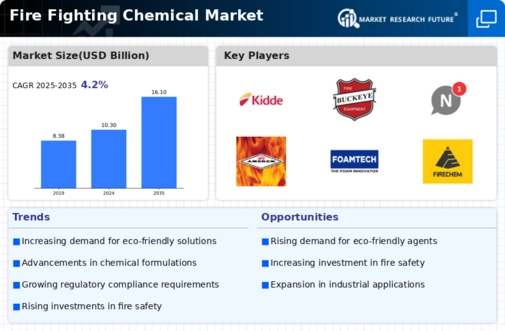Fire Fighting Chemical Market Summary
The Global Fire Fighting Chemical Market is projected to grow from 10.27 USD Billion in 2024 to 16.07 USD Billion by 2035, reflecting a robust growth trajectory.
Key Market Trends & Highlights
Fire Fighting Chemical Key Trends and Highlights
- The market is expected to expand at a compound annual growth rate (CAGR) of 4.15 percent from 2025 to 2035.
- By 2035, the market valuation is anticipated to reach 16.1 USD Billion, indicating substantial growth opportunities.
- in 2024, the market is valued at 10.27 USD Billion, establishing a solid foundation for future expansion.
- Growing adoption of advanced fire suppression technologies due to increasing safety regulations is a major market driver.
Market Size & Forecast
| 2024 Market Size | 10.27 (USD Billion) |
| 2035 Market Size | 16.07 (USD Billion) |
| CAGR (2025-2035) | 4.15% |
Major Players
Tyco Fire Protection Products, 3M Company, Kidde, Sprinkler Fitters Local Union 669, Schutte Fire, Buckeye Fire Equipment, Notifier, Amerex, Anchor Fire Protection, Foamtec, FireChem, FireAde, Fireaway, Akron Brass, Chemguard, Viking Corporation



 Source: Primary Research, Secondary Research, MRFR Database and Analyst Review
Source: Primary Research, Secondary Research, MRFR Database and Analyst Review

















